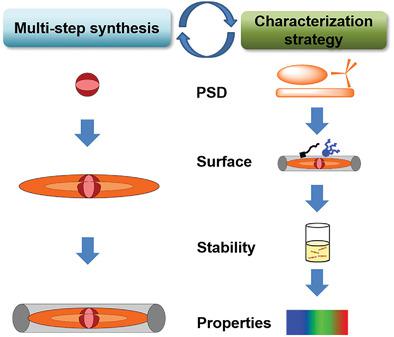当前位置:
X-MOL 学术
›
Part. Part. Syst. Charact.
›
论文详情
Our official English website, www.x-mol.net, welcomes your feedback! (Note: you will need to create a separate account there.)
Unraveling Complexity: A Strategy for the Characterization of Anisotropic Core Multishell Nanoparticles
Particle & Particle Systems Characterization ( IF 2.7 ) Pub Date : 2020-09-06 , DOI: 10.1002/ppsc.202000145 Wei Lin 1, 2 , Christoph Greve 3 , Sebastian Härtner 3 , Klaus Götz 4 , Johannes Walter 1, 2 , Mingjian Wu 5 , Stefanie Rechberger 5 , Erdmann Spiecker 5 , Sebastian Busch 6 , Tilo Schmutzler 4 , Yamini Avadhut 7 , Martin Hartmann 7 , Tobias Unruh 4 , Wolfgang Peukert 1, 2 , Doris Segets 8
Particle & Particle Systems Characterization ( IF 2.7 ) Pub Date : 2020-09-06 , DOI: 10.1002/ppsc.202000145 Wei Lin 1, 2 , Christoph Greve 3 , Sebastian Härtner 3 , Klaus Götz 4 , Johannes Walter 1, 2 , Mingjian Wu 5 , Stefanie Rechberger 5 , Erdmann Spiecker 5 , Sebastian Busch 6 , Tilo Schmutzler 4 , Yamini Avadhut 7 , Martin Hartmann 7 , Tobias Unruh 4 , Wolfgang Peukert 1, 2 , Doris Segets 8
Affiliation

|
In this work, a widely applicable routine to characterize the core, surface, stability, and optical properties of CdSe/CdS/ZnS core–shell–shell nanorods after multiple growth steps is established. First, size, shape, and shell thickness of the nanorods are characterized by transmission electron microscopy (TEM), analytical ultracentrifugation (AUC), and small angle X‐ray/neutron scattering (SAXS/SANS). In the next step, Fourier‐transform infrared (FT‐IR) spectroscopy, thermogravimetric analysis (TGA), and SANS measurements are applied to determine the surface species of nanorods. Then, the colloidal stability of the nanorods is investigated by UV–vis spectroscopy and dynamic light scattering (DLS) after different washing cycles. Finally, photoluminescence quantum yield (PLQY) of the nanorods during washing and sample storage is determined. With this highly complementary routine for particle characterization, the core, surface, stability, and optical properties of nanorods after multiple growth steps are resolved. The results demonstrate the importance of the developed toolbox to characterize such highly complex, anisotropic nanorods for a technical environment. This is of major importance for the handling of colloidal quantum materials and their quality control in industrial applications.
中文翻译:

解开复杂性:各向异性核心多壳纳米粒子表征的策略。
在这项工作中,建立了一个广泛适用的程序,用于在多个生长步骤后表征CdSe / CdS / ZnS核-壳-壳纳米棒的核,表面,稳定性和光学性质。首先,通过透射电子显微镜(TEM),分析超速离心(AUC)和小角度X射线/中子散射(SAXS / SANS)表征纳米棒的大小,形状和壳厚度。下一步,应用傅立叶变换红外(FT-IR)光谱,热重分析(TGA)和SANS测量来确定纳米棒的表面种类。然后,通过紫外可见光谱和不同洗涤周期后的动态光散射(DLS)研究了纳米棒的胶体稳定性。最后,确定了纳米棒在洗涤和样品存储过程中的光致发光量子产率(PLQY)。使用这种高度互补的例程进行颗粒表征,可以解决多个生长步骤后纳米棒的核心,表面,稳定性和光学性质。结果表明,开发的工具箱对于表征技术环境中高度复杂的各向异性纳米棒的重要性。这对于胶体量子材料的处理及其在工业应用中的质量控制至关重要。
更新日期:2020-09-06
中文翻译:

解开复杂性:各向异性核心多壳纳米粒子表征的策略。
在这项工作中,建立了一个广泛适用的程序,用于在多个生长步骤后表征CdSe / CdS / ZnS核-壳-壳纳米棒的核,表面,稳定性和光学性质。首先,通过透射电子显微镜(TEM),分析超速离心(AUC)和小角度X射线/中子散射(SAXS / SANS)表征纳米棒的大小,形状和壳厚度。下一步,应用傅立叶变换红外(FT-IR)光谱,热重分析(TGA)和SANS测量来确定纳米棒的表面种类。然后,通过紫外可见光谱和不同洗涤周期后的动态光散射(DLS)研究了纳米棒的胶体稳定性。最后,确定了纳米棒在洗涤和样品存储过程中的光致发光量子产率(PLQY)。使用这种高度互补的例程进行颗粒表征,可以解决多个生长步骤后纳米棒的核心,表面,稳定性和光学性质。结果表明,开发的工具箱对于表征技术环境中高度复杂的各向异性纳米棒的重要性。这对于胶体量子材料的处理及其在工业应用中的质量控制至关重要。



























 京公网安备 11010802027423号
京公网安备 11010802027423号